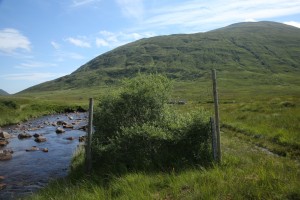
On the morning of the last of the three days I spent on the West Affric Estate in August, I took a different route to my four colleagues. They were crossing the Affric River to look at a new planting site on land managed by Forestry Commission Scotland, which is planned to extend the native woodland southwards, along the east side of the Allt a’ Chomhlain watercourse. While they did that, I took the opportunity to go west from the Alltbeithe Youth Hostel, where we were staying, to look at a couple of small areas on West Affric that I’ve been photographing for many years.
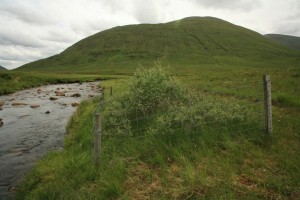
My initial destination, and the subject of this blog, was a small stock-fenced exclosure that was erected by our volunteers in 1997 to protect an eared willow (Salix aurita) seedling that was growing beside the Allt Gleann Gniomhaidh, just upstream of its convergence with the Allt Camban to form the Affric River itself. This is similar to the exclosure I wrote about in my first blog from this trip to West Affric, but unlike that one, where red deer (Cervus elaphus) had destroyed the fence and eaten the bluebells and eared willow that it protected, this one was still intact.
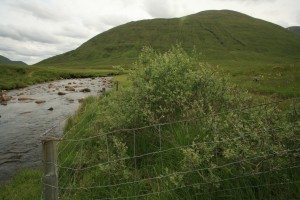
Although the exclosure was fenced in 1997, it was only in 2008 that I began photographing it, and I’ve been doing so at three or four year intervals since then. Thus, I made a return visit to the site in early June 2012 and then again in the middle of August this year. It is one of about a dozen such exclosures we’ve erected along the Affric River and its major tributary, the Allt Gleann Gniomhaidh, and in fact it has the largest eared willow bush of any of them growing in it.
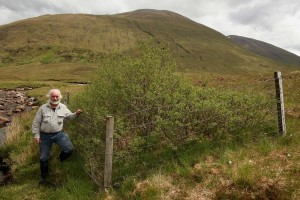
The exclosure measures something like 2.5 metres wide by 4 metres long, and is almost entirely filled by the eared willow now. At this stage, it’s impossible to say if there is one or several bushes there, filling the entire exclosure, but I suspect there may have been more than one seedling originally, when the fence was put up in 1997, because of the size of it. Most of the other stock-fenced exclosures protecting other similar eared willow bushes are smaller than this.
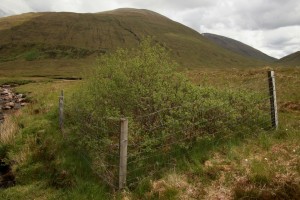
There are no mature trees anywhere near this exclosure on the West Affric Estate, which is owned by the National Trust for Scotland (NTS), but immediately to the south (and visible on the left in the distance in the photograph here), is an exclosure put up by Forestry Commission Scotland in the 1990s, which we planted with native trees then. The trees were mostly Scots pines (Pinus sylvestris), and in addition to them growing well, there’s also been a change in the ground vegetation, with heather (Calluna vulgaris) replacing grasses, and this is also apparent in the photograph.
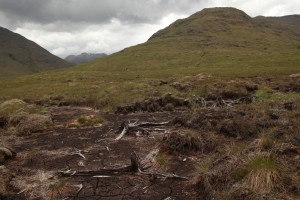
However, not far from the small eared willow exclosure there’s a large expanse of peat hags. These are areas where the vegetation has been eroded by the elements, exposing the underlying peat, often with the stumps of Scots pines preserved in them. In some cases these stumps have been dated to 4,000 years old, but in other situations they are much more recent. Because of overgrazing by deer, no vegetation is able to recolonise the exposed peat, so the hags remain as open wounds on the land, unable to heal at all.
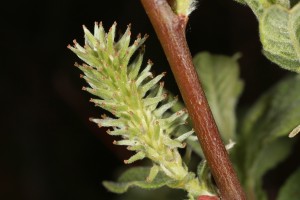
The peat hags provide a dramatic and sad contrast to the eared willow that is flourishing inside the exclosure, and when I had visited it in early June of 2012 the bush had been flowering. Eared willow is dioecious, meaning that individual bushes are either male or female, whereas many trees (such as birch, oak, Scots pine etc) have both male and female flowers on the same plant. The only time to sex an eared willow therefore is when it is in flower and in 2012 I saw that this one is a female. The flowers of male eared willows are more like the typical ‘pussy willows’, and usually start blooming earlier in the spring than the females.
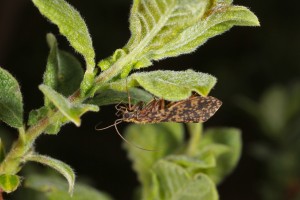
At the time of my visit in August this year, there were no flowers left on the bush, but I was hoping to see a variety of insects instead. In 2012, there had been a diverse range of invertebrates on the bush, and it had seemed to be literally teeming with life. One of the first species I’d seen then was a caddis fly (Philopotamus montanus). This is one of the most distinctive of the caddis flies found in the UK, and the larvae typically occur in fast flowing upland streams. Adults emerge between April and August, and often rest on trees beside the watercourse where they have spent their larval stage, so it’s possible this one was a newly-emerged adult, sitting on the eared willow not long after it had gained its adult form.
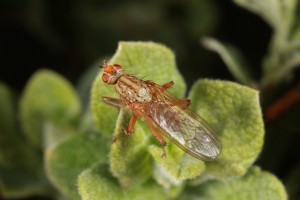
On another part of the bush I saw a distinctive pale orange fly which was familiar to me as being a dung fly (Scatophaga sp.). There are several species in the genus, and one of them, the yellow dung fly (Scatophaga stercoraria), has been extensively studied as it is one of the most common fly species in the northern hemisphere. As their name suggests, these flies are often found on dung: the female lays her eggs on the faeces of large mammals such as cows, sheep and deer. The fly’s larvae feed on the dung, helping to recycle the nutrients contained within it back into the living organisms that comprise the natural ecosystem. I haven’t been able to get this particular fly definitively identified, but Peter Chandler, an expert on two winged flies who helps me with identifications, has suggested that it could be Scatophaga lutaria.
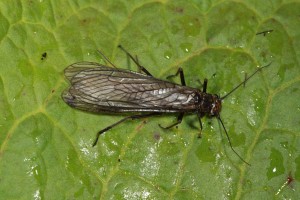
Another insect I spotted on the eared willow in 2012 was a stonefly. Like the caddis fly I wrote about above, stoneflies are another group of invertebrates whose larval stages grow and develop in freshwater. After pupation, the winged adult forms take to the air to mate, with the females laying eggs on the water to continue their life cycle. I had to send this stonefly off to a specialist to get it identified – it was a species called Perla bipunctata – and I photographed it on a leaf at home before putting it in the post.
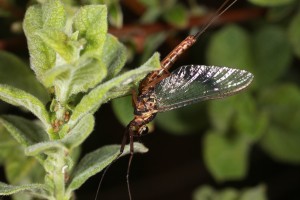
Like the caddis fly, the stonefly was probably resting on the eared willow after having recently emerged as an adult. On another part of the bush on that day in June 2012, I found a third different insect that also has an aquatic larvae stage and a winged adult form: a mayfly. Mayflies are readily distinguishable as a group because of their general body shape, which include long tails, and the fact that the wings do not fold flat over the abdomen. It’s not possible to name the one here from the photo alone, and I didn’t catch the specimen, so I’ve not been able to get it positively identified, but it could be a species called Siphlonurus lacustris.
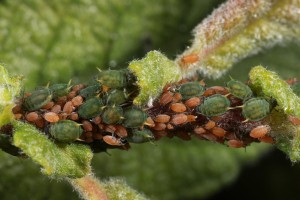
While I was photographing the mayfly, I noticed some brightly coloured small insects on the stem of the eared willow, and when I looked closer I was excited to discover they were aphids. They are a group of insects that I have developed a particular interest in, because of their fascinating life cycles and ecological relationships, and I’ve written about them in several blogs before. I didn’t recognise this species on the eared willow, but I was able to identify it from a simple web search as being the small willow aphid (Aphis farinosa).
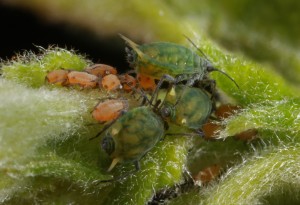
This is quite a common aphid species, often being found in dense colonies like this in spring and early summer on the fresh shoots of willows, such as the eared willow and goat willow or sallow (Salix caprea). It is notable in having distinct colour differences between the males, which are orange, and wingless females, or apterae, which are green with mottled yellow blotches on them. The nymphs – the earlier life cycle stage of the aphids – are also orange, as can be seen here. The apterae are able to reproduce parthenogenetically (i.e. without mating), while the oviparae, or sexual females that mate with males and lay eggs, appear later in the summer and are dull green. The alates, or winged forms, of this species are dark green in colour.
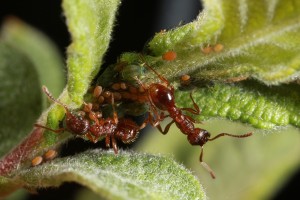
There were large colonies of the aphids covering several sections of the eared willow bush, and I was impressed by the sheer numbers of them, especially since they were on a willow that was so far from any woodland. The only other willows within several kilometres were the handful inside the other stock fenced exclosures we’ve erected alongside this section of the Affric River and its tributary, the Allt Gleann Gniomhaidh. As I looked at the aphids I noticed that some of the colonies were being tended by red ants (Myrmica ruginodis).
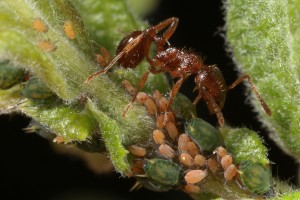
Aphids feed by sucking the sap of their host plants, and they secrete a clear liquid known as honeydew as a waste product. With various aphid species, their honeydew forms a food source for ants, and the ants ‘tend’ the aphids, stroking them with their antennae, to stimulate the excretion of honeydew. This is a mutually beneficial or symbiotic relationship, as the ants protect the aphids, helping to discourage predators and parasites, which otherwise find the relatively immobile aphids to be easy targets.

As I looked at the aphids I noticed that various other insects seemed to be attracted to them. I was able to photograph one which I recognised as a large ichneumonid wasp – a group that are parasitoids of other insects, including aphids. However, this individual, which I was able to get identified as being a male of a species called Alomya debellator, was clearly too large to be a parasitoid of aphids, and in any case it is the females that carry out the act of parasitism, when they inject their eggs into their host species.
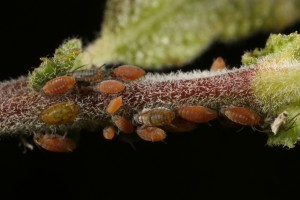
I later discovered that this particular ichneumonid wasp is known for feeding on the honeydew of aphids, and that was what this individual was doing in 2012. In fact, a wide range of insects utilise aphid honeydew as a food source, including many hoverflies, bees and flies. Having seen so much life on this eared willow in 2012, I was keen to see if it was similarly a-buzz with insects during this next visit, in August 2015. I was particularly interested to discover if the aphids were still there, and I did indeed find some, but not as many as I’d seen in 2012.
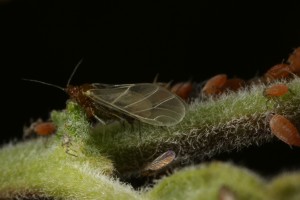
This variation in numbers between the years may have been due to the fact that this aphid species is typically more abundant in spring and early summer, and by the middle of August this year they may have passed their population peak for the season. Interestingly enough, though, I did see some winged, or alate, forms of the aphid this time, which I hadn’t seen in 2012, and I suspect that those appear at a later stage in the annual life cycle of the species, hence the reason they were visible in August.
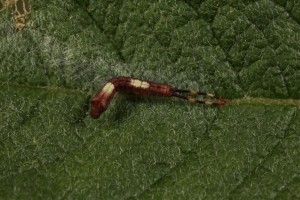
I didn’t have so much time to spend with this eared willow bush this year as in 2012, because I was due to meet my colleagues back at the youth hostel at lunch time, but I did have a quick look around to see what other life there was on it. My eye was drawn by small shapes on several of the leaves, and when I looked closely at them, I saw that they were the young larvae of the puss moth (Cerura vinula). The caterpillars of this species are unmistakable, and are characterised by having a forked tail, which they flick about in a threat display when they are disturbed.
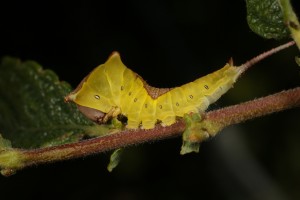
Like all caterpillars, those of the puss moth go through various stages of development and growth, known as instars, separated from each other by moults, in which the skin of the former stage is shed. Whilst some lepidopteran species have similar shapes in their successive instars, the puss moth caterpillar goes through a series of dramatic changes in colour and shape as it grows, and as I continued looking at the leaves of the eared willow I found several examples of later instars on it.
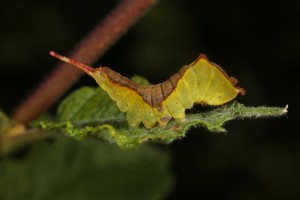
These were bright yellow in colour, with a distinctive hump on the back. The final instar of the puss moth caterpillar is particularly spectacular as it has a red ring around its face, giving it quite a fierce appearance. The moth itself gets its name from the appearance of the adult, which is covered in soft, off-white hairs, giving it a furry, cat-like appearance. The caterpillars feed on willows and trees in the poplar family, such as aspen (Populus tremula), and I saw at least a dozen on this eared willow during my visit in August.
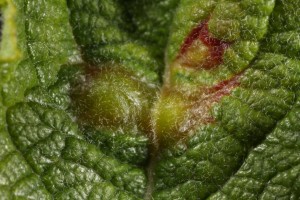
Some of the leaves of the eared willow had small swellings, or pustules, on their upper surface, and these are galls induced by a midge (Iteomyia capreae). Galls are abnormal growth that a plant or tree is stimulated to produce by another organism, such as an insect, a mite or a fungus. The exact mechanism by which the gall-inducing organism makes the plant produce the gall is not fully known or understood, but galls such as these on this eared willow each house a larva of the midge.
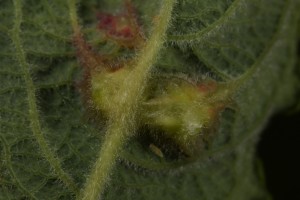
The larvae are able to grow inside the protection provided by the gall, and feed on special nutritive tissues that the plant is stimulated to provide by the gall causer. In essence, the gall relationship is a parasitic one, as the gall inducer gains from it, while the host plant does not. Instead, the host is stimulated to divert some of its resources to the gall-inducing organism, that would otherwise be used for its own growth. Galls often occur in remarkable shapes and forms, and how the gall inducer has evolved the means to make its host do this is an enduring mystery of Nature.
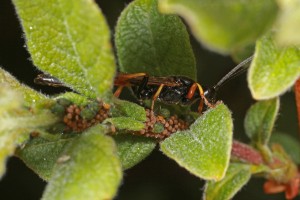
As I left the eared willow on that day in August, I paused to think about how much life I’d seen on it during these two brief visits, now and back in June 2012. This included a gall-inducing midge, a caddis fly, a mayfly, a stonefly, a dung fly, aphids, red ants, an ichneumon wasp and the puss moth caterpillars, not to mention the other insects I wasn’t able to photograph or identify by sight alone. All of this life was able to thrive there because this one eared willow bush was growing out of reach of deer inside the stock fence our volunteers had erected.
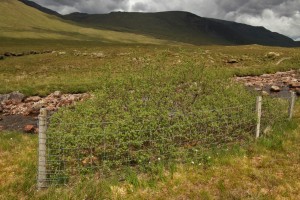
In the 1950s, the pioneering British conservationist Sir Frank Fraser Darling famously described the northwest Highlands as a ‘wet desert’, because the ecological degradation that has taken place there has made the region desert-like in its impoverishment, even though it isn’t dry and sandy like other deserts. With much of the area still in that condition today, as evidenced by the peat hags and lack of tree regeneration in the upper Affric watershed, this eared willow bush is a literal oasis of life. It shows how much diversity and abundance will return to the Highlands when we redress the problem caused by overgrazing from excessive numbers of red deer, that is keeping the land in such a depleted state today.
Nice detail of often ignored species – very interesting.
Fences still seem to be a necessary intrusion even though the NTS Wild Land Policy presumes against them… Mar Lodge seemed to do well latterly with heavy culls surrounding regeneration zones. Can an agreement for targeted culling in regeneration areas be made and direct some more effort towards control? These little ‘salad bowls’ will be very tempting for stravaigers from Kintail, Affric and beyond. I still can’t quite get my head around fencing for the future – will we deal with the issue in the interim or just see a generation or two of trees then back to the wet desert?
Stunning and beautiful. What close and intimate way to look at a willow bush in the middle of the wet desert in West Affric. Thank you for having protected that eared willow for a couple of decades and for having a hand in so much life thriving on the willow. Thanks for calling life back to the land.